Hittites and Cappadocians
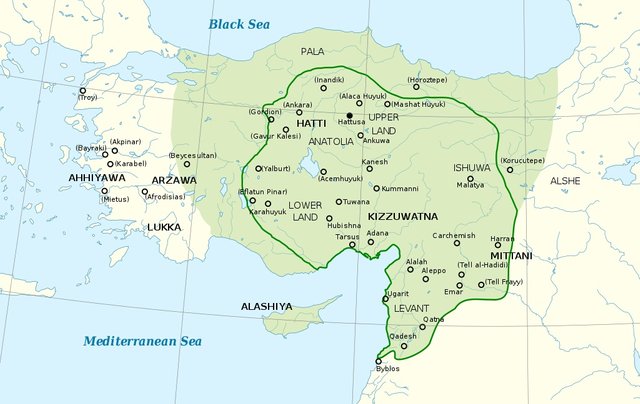
The Restoration of Ancient History is a paper delivered in November 1994 by Gunnar Heinsohn, Professor Emeritus at the University of Bremen in Germany, at a symposium in Portland, Oregon. This paper questions the conventional chronology of ancient history and offers in its place a radical reconstruction—the so-called Short Chronology, of which Heinsohn is the principal architect. In this series of articles, we are taking a closer look at the evidence cited in this paper in favour of Heinsohn’s new chronology:
Heinsohn recognizes four periods in the history of Mesopotamia before the conquests of Alexander the Great:
| Dates BCE | Assyria | Babylonia |
|---|---|---|
| 1150-750 | Early Assyrians | Early Chaldaeans |
| 750-620 | Assyrian Empire | Assyrian Empire and Scythians |
| 620-540 | Empire of the Medes | Chaldaeans |
| 540-330 | Persian Empire | Persian Empire |
In this article we will continue our survey of Part 3 of Heinsohn’s lecture: Archaeologically-missing history and historically-unexpected archaeology in major areas of antiquity.. In this section, Heinsohn reviews a long list of cases where archaeologists have discovered major discrepancies between the archaeology of the Ancient World and its history as recorded by the Classical historians. These discrepancies fall into two broad categories:
Excavations in which the archaeologists failed to find strata that the recorded history had led them to expect.
Excavations in which the archaeologists uncovered strata that did not correspond to any cultures or civilizations in the recorded history.
Heinsohn noticed that many of these discrepancies come in matching pairs. For example, in earlier articles we met the following pairs:
- The Chaldaeans and the Sumerians
- The Medes and the Mitannians
- The Assyrians and the Akkadians
In this article we will be taking a look at another of Heinsohn’s matching pairs: the Hittites and the Cappadocians of Anatolia.
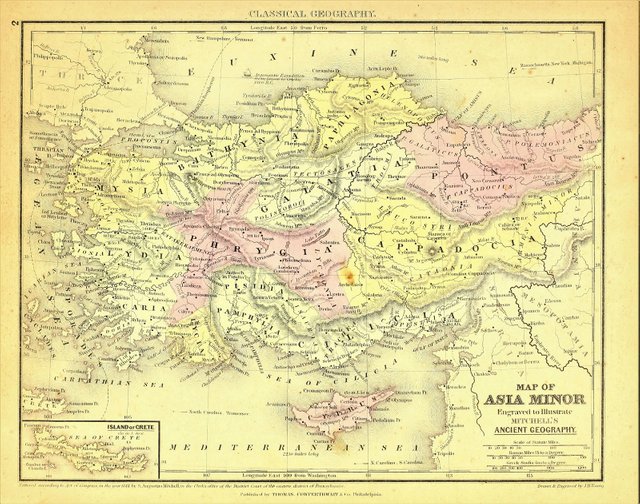
Heinsohn and the Hittites
As before, Heinsohn equates four periods in the recorded history of the Anatolian Plateau with four archaeological strata which he believes have been misdated:
| Heinsohn’s Dates BCE | History | Archaeology | Conventional Dates BCE |
|---|---|---|---|
| 1150-750 | Predecessors of Kat/Khat | Pre-Hittite Early Bronze Age | 2100-1700 |
| 750-620 | Ketoi (Odyssey 11:521) of pre-Medish Ninos-Assyrians | Hittite Old Empire | 1700-1500 |
| 620-550 | Kat/Khat of Katpatuka (Cappadocia) contemporary with Empire of the Medes | Hittite Empire contemporary with Mitanni | 1500-1300 |
| 550-330 | Kat/Khat of 19th Persian Satrapy, Katpatuka | Hittite Late Empire | 1300-1100 |
Like the Sumerians, Akkadians and Mitannians, the Hittites are a people of the ancient world who do not figure in the works of the Classical historians. You will not read of them in the pages of Herodotus or Diodorus Siculus, and yet we are assured by modern historians that they once ruled a vast empire that rivalled Egypt, Assyria and Babylon. How can this be?
The discovery—or rediscovery—of this empire and its ascription to a people called the Hittites was largely the work of an Irish missionary to Damascus William Wright. Wright spent about ten years in the Middle East (1865-75), during which time he investigated a set of stone inscriptions that had been recently discovered in the Syrian city of Hama, the Biblical Hamath:

During the ten years that he spent in the East he acquired a knowledge of Arabic, studied the customs and topography of Palestine, and made expeditions in Syria and Northern Arabia ... While in Syria he made casts of the Hamath inscriptions, and from further investigations came to the conclusion that they were Hittite remains and that a Hittite empire had at one time existed in Asia Minor and Northern Syria. In 1884 he published The Empire of the Hittites (London, 8vo), with a conjectural decipherment of Hittite inscriptions by Professor Archibald Henry Sayce, who had come to similar conclusions. A second edition of the book appeared in 1886, and Wright contributed the article on the “Hittites” to Chambers’s Encyclopædia in 1895. The whole subject is still rather obscure, but Wright must be credited with assisting materially to elucidate it. (Lee 139)
Today a distinction is usually made between Wright’s Hittites, whose heartland lay on the Anatolian Plateau, within the bend of the Kizil Irmak (ie the Halys River, or Marassantiya), and the Hittites mentioned in the Bible. Wright and Sayce, however, clearly believed that they were one and the same people (Patrick 724).
In the fourth chapter of Ramses II and His Time—one of the volumes of his Ages in Chaos series—Immanuel Velikovsky gives an engaging account of Wright’s discoveries:

At the end of the eighteenth century bas-reliefs with peculiar pictographic inscriptions were noticed and pointed out by travelers passing near Ivriz, on the plateau of Asia Minor. Later travelers saw similar pictorial signs carved on stone that had been re-used in a building at the bazaar of Hamath in northern Syria. The same peculiar signs were observed on slabs in the area of Jerablus-Carchemish on the bank of the Euphrates, and later on the site of ancient Babylon and in other places. They are completely different from Egyptian hieroglyphics. It was not known which people had left these mysterious inscriptions.
On the other hand, mention of the Kheta in the texts accompanying the bas-reliefs of the battle of Kadesh, in the poem celebrating this battle, and in the Egyptian text of the peace treaty between Egypt and Kheta stimulated conjecture about the identity of the rivals of Ramses II in the struggle for dominion over the ancient world. Who were the Kheta?
In the 1870’s a solution was offered and accepted: the Kheta were the Hittites, occasionally mentioned in the Scriptures. It was the phonetic similarity of the names that prompted this identification.
William Wright, a missionary in Damascus, came to this conclusion and also decided that the mysterious signs are Hittite writings. Since almost nothing was known of Hittite history, it was like resurrecting an empire from oblivion, and it was called “a discovery of a forgotten empire.” However, warning voices were also heard among scholars who were opposed to the idea, very strange to them, that the ancient world of the empires of Egypt and Assyro-Babylonia should be increased by a newly discovered empire of the Hittites. (Velikovsky 60)
The subsequent discovery of the royal archives of these Hittites in the ruins of the ancient city of Ḫattuša on the Anatolian Plateau was a godsend for the archaeologists. More than 10,000 cuneiform tablets were eventually recovered, written in more than half-a-dozen different languages—some of which were unknown to scholars. With the help of these records and numerous synchronisms with the already well-attested empires of Egypt, Assyria, Mitanni and Babylonia, a timeline of Hittite history was reconstructed:

The Biblical name Hittite was first conferred on these people by the German Egyptologist Heinrich Karl Brugsch. In A History of Egypt under the Pharaohs, we read:
Already, during the wars undertaken by Thutmes III against the Syrian peoples and towns of that region, the Kheta or Khita had shown themselves on the scene of those yearly repeated and long-enduring struggles, under the leadership of their own kings, as a dominant race. The contemporary Egyptian inscriptions designate them as “the great people,” or “the great country,” less with respect to the space they occupied, than from their just reputation for those brave and chivalrous qualities, which the inhabitants of Khita, a race as noble as the Egyptians, were acknowledged even by their enemies to possess. We believe we are falling into no error if we persevere in our opinion, which recognises in these people the same Khethites (Hittites) about whom Holy Scripture has so much to tell us, from the days of the patriarch Abraham till the time of the Captivity. (Brugsch 2:2)
The Kheta of Egyptians inscriptions were believed to be the same people referred to in Akkadian (ie Assyrian and Babylonian) texts as Ḫatti or Khatti:
The decipherment of the inscriptions of Egypt and Assyria has thrown a new light upon [the Hittites’] origin and history, and shown that the race to which they belonged once played a leading part in the history of the civilised East. On the Egyptian monuments they are called
Kheta (or better Khata), on those of Assyria Khatta or Khate, both words being exact equivalents of the Hebrew Kheth and Khitti. (Sayce 19)
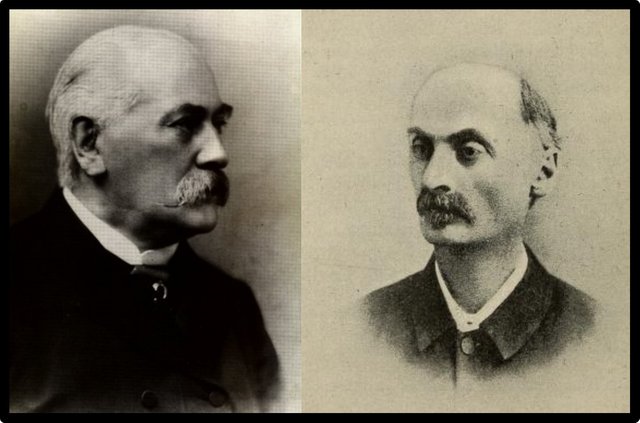
Today Kheta and Hatti have become the standard forms of these names, but other transcriptions are also found in the literature.
Egyptian records actually refer to the country as KH-T-Tꜣ, which is spelt using three phonetic hieroglyphs (to which is added the determinative for “foreign land” and sometimes also that for “enemy”). This is usually vocalized today as Kheta, but this pronunciation is little more than an educated guess (Bryce 9). The initial sound—the placenta or sieve—corresponds to the Hebrew letter heth, which was either a voiceless pharyngeal fricative [ħ] or a voiceless velar fricative [x] (Budge 1920:525). Elsewhere, Budge identifies it as a voiceless uvular fricative, [χ], like the ch in the German _Bach (Budge 1902:31). The second sign—the loaf of bread—denotes a voiceless alveolar stop, [t]. The third sign—the potter’s kiln—may be acting as a determinative, as it can mean “land” or “country”, but it is primarily a phonetic sign, tꜢ. The two half-rings represent the Egyptian alef, the pronunciation of which is still uncertain. According to the Egyptologist Alan Gardiner, the correct reading of this hieroglyph is simply Ḫt. In Gardiner’s example, from the reign of Thutmose III, aleph is represented by the vulture hieroglyph (Sethe 701):

The Akkadian Ḫatti begins with a voiceless velar fricative, [x], like the ch in the Irish or Scottish Gaelic loch. Assyriologists usually write this letter as Ḫ.
Not everyone agreed that the Egyptian Kheta and the Assyrian Ḫatti corresponded to the Biblical Khitti [חתי] (Strong 45) or Hittim [חתים] (Judges 1:26). The German orientalist Friedrich Max Müller argued that these toponyms ought to be linked to the Biblical Kittim [כתים]. This is an interesting idea, as Kittim came to be associated with the islands of the eastern Mediterranean, including those of the Aegean Sea. In 1 Maccabees 1:1, Alexander the Great is said to have come from the “land of Kittim”.
Kittim begins with a kaph, the eleventh letter of the Hebrew alphabet. When kaph is marked with a dagesh (dot) in its centre, כּ, it represents a voiceless velar plosive, [k]. When kaph appears as כ without the dagesh, it represents a voiceless uvular fricative [χ]. In Kittim, the dagesh is present, but as these diacritics were only added to the Scriptures in the Middle Ages by the Masoretes, it is possible that Khittim was the original form, bringing it into line with the Egyptian and Akkadian forms. Hittim begins with a heth, the eighth letter of the alphabet, which originally represented a voiceless fricative, either pharyngeal [ħ], or velar [x], both of which resemble the voiceless uvular fricative [χ].
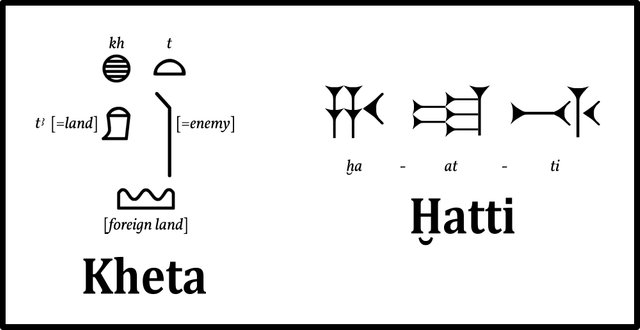
Hattians and Hittites
Hittite is certainly not the correct name for this people or their language. Archaeologists and historians do seem to have a penchant for bestowing modern and inappropriate names on ancient peoples (eg Minoans, Mycenaeans, Sumerians), but how were these people saddled with this name?
Wright’s “Hittites” were not the first civilized nation to inhabit the Anatolian Plateau. Before them, this region had been home to the mysterious Hattians of the Early Bronze Age. Kheta and Hatti clearly refer to these predecessors. The Hattians established a number of monarchical city-states on the Anatolian Plateau. Hatti, with its capital at the ancient settlement of Hattuš, was the name of one of these petty kingdoms.
Another people known as the Hurrians had also established themselves in this region before the appearance of the Hittites. Like Hattic, the Hurrian language was unrelated to that of the Hittites. Hurrian was, however, the native language of the subjects of the neighbouring kingdoms of Mitanni in northern Syria and of Urartu in Armenia. The origins of the Hurrians are obscure—as, indeed, are the origins of the Hattians and the Hittites.
The native language of the “Hittites” belongs to the Indo-European family of languages. The Hattians and Hurrians, however, spoke non-Indo-European languages. Hattic and Hurrian are not related to any of the other languages of the Ancient World. Nor are they related to each other.
The Hittites referred to their own language as Nešili (Nesite), meaning the language of Neša. The city of Nesha or Kanesh, which was continuously occupied from the Chalcolithic Era until Roman times, has been identified with the archaeological site of Kültepe in central Turkey. During the late Proto-Hittite Period (c 1700 BCE in the conventional chronology), Anitta, the Hittite King of Kussara, conquered Neša and made it his new capital.
What, then, did the “Hittites” call themselves? Apparently, they referred to themselves simply as Neshians, ie people of Neša, and sometimes as men of Hatti. It is not known what they called themselves—if anything—before they migrated to Anatolia.

Conventional Hittite History
The conventional history of the Hittites can be briefly recounted. By 2000 BCE, several small Hittite states had established themselves on the Anatolian Plateau alongside Hattian and Hurrian kingdoms. Assyrian traders also founded colonies on the plateau in the following centuries. In fact, the history of this period is largely based on Assyrian texts. Towards the end of this Proto-Hittite Period, the Hittite King of Neša defeated the King of Hatti and sacked his capital at Hattuš:
Increasingly turbulent conditions in the region where the Assyrian merchants traded were almost certainly responsible for the abrupt end of this trade around the middle of the eighteenth century. There followed a period, lasting several decades or more, of which we have very little knowledge, and no written records. (Bryce 23)
The so-called Old Kingdom was established in the early 17th century by a shadowy figure called Labarnas I. Labarnas established a dynasty that ruled a sizeable kingdom from the rebuilt Hattuš—Ḫattuša in Hittite—for about two hundred years.
The eighth and final ruler of the Old kingdom, Telepinu, died around 1500 BCE. This event marked the end of the Old Kingdom and the beginning of the period known as the Middle Kingdom. For about half a century, Ḫattuša was ruled by a succession of five or six weak monarchs. Little is known of this period. The Hittites appear to have been on the back foot. Among their enemies, the mysterious Kaska were the most prominent.
The Hittite Empire (or New Kingdom) was established sometime around 1450-1400 by Tudhaliya I, whose lineage is uncertain. The Empire represents the acme of Hittite civilization. Over a period of about 250 years, a succession of fifteen or so kings presided over the fluctuating fortunes of the nation. It is possible that the ruling dynasty was not actually Hittite but Hurrian—or at least Hurrianized. In 1274 BCE, when the Empire was at its height, the Hittites were powerful enough to contest the mastery of Syria with Ramesses II of Egypt. The culminating Battle of Kadesh was strategically indecisive and led to a peace-treaty between the two nations.
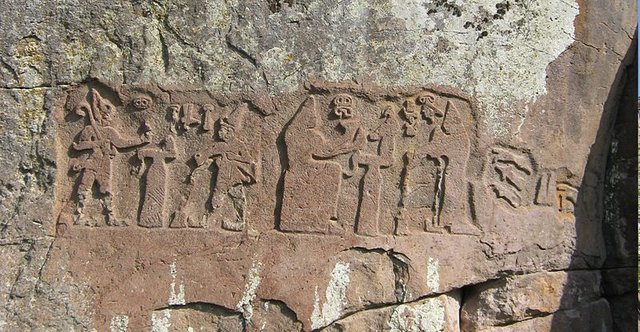
After this, both Egypt and Ḫatti were eclipsed by the rise of Assyria. The best days of the Hittites were behind them. The final century was one of continual decline, exacerbated by domestic strife and civil war. The last king, Šuppiluliuma II, survived the onslaught of the so-called Sea Peoples, but shortly afterwards he vanished from the records without a trace. It is thought that the final sacking of Ḫattuša was carried out by the Kaska, the Phrygians or the Mysians sometime between 1190 and 1178 BCE, but this is disputed by some scholars. According to recent excavations, Šuppiluliuma II may have abandoned the city before it fell, but it is not known where he went.
The final collapse of the Hittite Empire occurred shortly after the disappearance of one of its main rivals, the kingdom of Mitanni.
Following the ruin of the New Kingdom, there arose a number of independent Hittite states in the south-eastern provinces of the former Empire. Here a strange afterglow of Hittite civilization survived for almost half a millennium. Perhaps Šuppiluliuma II founded one of these states:
Assyrian records continue to refer to Syria and the Taurus area as the “Land of Hatti” and speak of kings bearing names like Sapalulme, Mutallu, Katzili, and Lubarna. (Gurney 41)
The last of these Syro-Hittite or Neo-Hittite states was conquered by the Neo-Assyrian Emperor Sargon II in 709 BCE:
Thus ended the history of the Hittite states of North Syria. When Greek travellers penetrated into these territories, they found only provinces of the Assyrian Empire. The very name of Hatti was already forgotten. (Gurney 47)

So runs the conventional history of the Hittites, but among the unconventional historians—the revisionists—there are many competing models. In the next article in this series, we will take a look at some of these models.
And that’s a good place to stop.
References
- Friedrich Karl Brugsch, A History of Egypt under the Pharaohs, Volume 1, John Murray, London (1879)
- Friedrich Karl Brugsch, A History of Egypt under the Pharaohs, Volume 2, John Murray, London (1879)
- Trevor Bryce, _ Warriors of Anatolia: A Concise History of the Hittites_, I B Tauris & Co, Ltd, London (2019)
- Ernest Alfred Wallis Budge, Easy Lessons on Egyptian Hieroglyphic, Kegan Paul, Trench, Trübner & Co Ltd, London (1902)
- Ernest Alfred Wallis Budge, An Egyptian Hieroglyphic Dictionary, Volume 1, John Murray, London (1920)
- Alan Gardiner, Egyptian Grammar: Being an Introduction to the study of Hieroglyphs, Griffith Institute, Ashmolean Museum, Oxford (1927, 2001)
- Oliver Robert Gurney, The Hittites, Penguin Books Ltd, Harmondsworth, Middlesex (1952, 1981)
- Gunnar Heinsohn, Catastrophism, Revisionism, and Velikovsky, in Lewis M Greenberg (editor), Kronos: A Journal of Interdisciplinary Synthesis, Volume 11, Number 1, Kronos Press, Deerfield Beach, FL (1985)
- Gunnar Heinsohn, The Restoration of Ancient History, Mikamar Publishing, Portland, OR (1994)
- Gunnar Heinsohn, Die Sumerer gab es nicht [The Sumerians Never Existed], Frankfurt (1988)
- Gunnar Heinsohn, Heribert Illig, Wann lebten die Pharaonen? [When Did the Pharaohs Live?], Eichborn Verlag, Frankfurt (1990)
- Gunnar Heinsohn, M Eichborn, Wie alt ist das Menschengeschlecht? [How Old Is Mankind?], Mantis Verlag, Gräfelfing, Munich (1996)
- Sidney Lee (editor), Dictionary of National Biography, Volume 63, Smith, Elder, & Co, London (1900)
- David Patrick (editor), Chambers’s Encyclopaedia, New Edition, Volume 5, William and Robert Chambers, Limited, London (1901)
- Archibald Henry Sayce, The Hittites: The Story of a Forgotten Empire, The Religious Tract Society, London (1890)
- Kurt Sethe, Urkunden der 18. Dynastie: Historisch-Biographische Urkunden, Volume 3, J C Hinrichs, Leipzig (1907)
- James Strong, Hebrew and Chaldee Dictionary, Eaton & Mains, New York (1890)
- Immanuel Velikovsky, Ramses II and His Time, Paradigma, Online (2010)
- William Wright, The Empire of the Hittites, James Nisbet & Co, London (1884)
Image Credits
- The Hittite Empire: © Ikonact and Sémhur, Creative Commons License
- Map of Anatolia: Samuel Augustus Mitchell, Mitchell’s Ancient Atlas, Classical and Sacred, Thomas, Cowperthwait & Co, Philadelphia (1849), James Hamilton Young (engraver), Public Domain
- William Wright: Missionary Herald of the Presbyterian Church in Ireland, 2 October 1899, Public Domain
- Immanuel Velikovsky: Donna Foster Roizen (photographer), © Frederic Jueneman, Creative Commons License
- Heinrich Karl Brugsch: Public Domain
- Archibald Henry Sayce: Public Domain
- Egyptian Hieroglyph (Kheta): Merenptah Stele, Egyptian Museum, Cairo, Brave heart (designer), Public Domain
- Assyrian Cuneiform (Ḫatti): Daniel C Snell, A Workbook of Cuneiform Signs, Undena Publications, Malibu (1979)
- Reconstructed City Wall of Hattuš: © Rita1234, Creative Commons License
- Rock Relief of Ḫattušili III at Firaktin: © Krähenstein, Creative Commons License
- Syro-Hittite States: Adapted from Neohititas, © Rowanwindwhistler, Creative Commons License
Online Resources
